(9AM EST – promoted by Nightprowlkitty)
Burning the Midnight Oil for Living Energy Independence
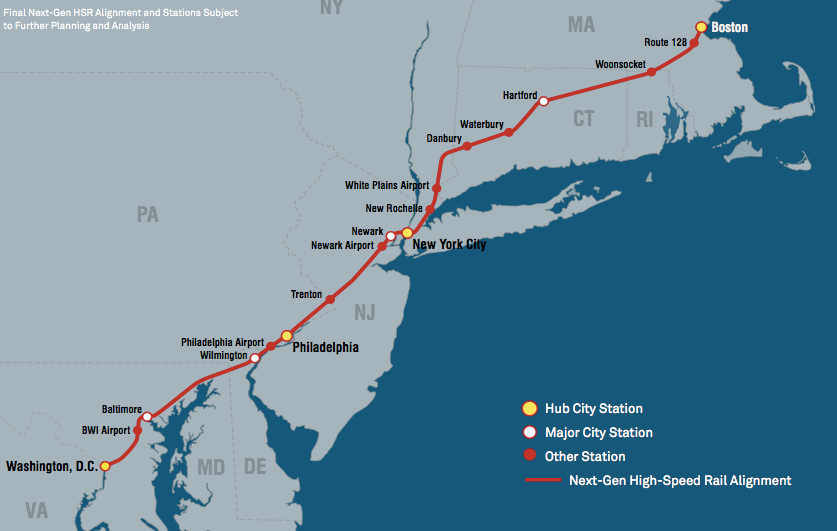 As The Transport Politic reported earlier this week: Amtrak Unveils Ambitious Northeast Corridor Plan, But It Would Take 30 Years to be Realized
As The Transport Politic reported earlier this week: Amtrak Unveils Ambitious Northeast Corridor Plan, But It Would Take 30 Years to be Realized
After months of sitting on the sidelines as states and regional agencies promoted major new high-speed rail investments, Amtrak has finally announced what it hopes to achieve over the next thirty years: A brand-new, 426-mile, two-track corridor running from Boston to Washington, bringing true [Express] high-speed rail to the Northeast Corridor for the first time.
Some questions and answers, over the fold.
Why HSR for the Northeast?
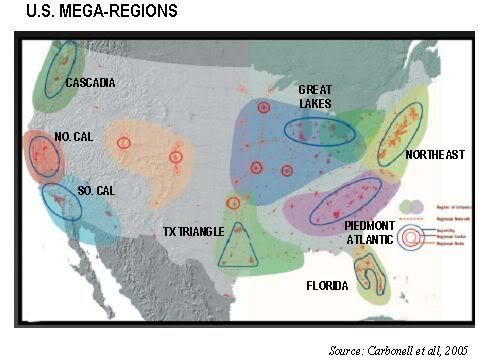 The argument that the report (pdf) presents for doing this at all can be summarized in three pictures. The one to the right is “Emerging Megaregions” view of US social geography in the century ahead. Connecting together these megaregions is conceived of as a major task that will be facing intercity transport in the coming half century.
The argument that the report (pdf) presents for doing this at all can be summarized in three pictures. The one to the right is “Emerging Megaregions” view of US social geography in the century ahead. Connecting together these megaregions is conceived of as a major task that will be facing intercity transport in the coming half century.
The report projects growth trends. Now, as shaky as any projection is, the alternative to doing them is to just wait until stuff happens and then start planning to fix it, and the risk there is what can be done as an emergency response is far inferior to what can be done if we plan ahead. And these projections lead to capacity projections for both Highway and Rail systems. And those two pictures (highway above, rail below) summarize the balance the of rationale:
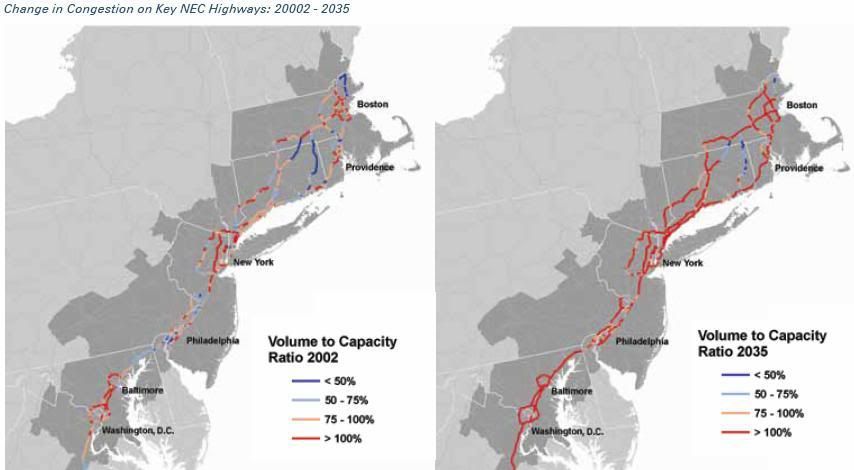
On highways local trips crowd out intercity trips. So people will want an alternative. Nowhere is it more likely than the Northeast that much of this demand will spillover into demand for rail transport, but the existing Northeast Corridor is projected to have six main congested segments: north DC, Baltimore, North MD / Delaware, urban Philadelphia, Trenton, Newark/NYC/New Rochelle, and Providence/Boston.
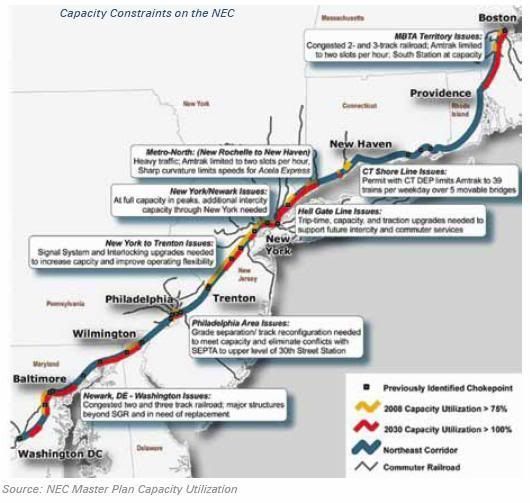
When you need new rail capacity, and the existing corridor is approaching its capacity, a new corridor is one solution to that problem. Given the cost of roadbuilding in the Northeast, where most easy road capacity expansion projects have already been done, $117b is likely to be substantially cheaper than trying to provide the same transport capacity by road, even assuming a fantasy world of ongoing cheap oil.
After all, that was the impetus for the first two bullet train systems, in Japan and France: existing mainline passenger rail corridors reaching capacity. When faced with that problem, build an all new Express HSR corridor, pull existing longer distance intercity passengers into the new corridor, and that frees up capacity on the existing corridor.
Why does it take 30 years?
 This also explains the “takes 30 years”. It could be done in substantially less time, but the planning study looked to provide for two segments to be completed by 2030:
This also explains the “takes 30 years”. It could be done in substantially less time, but the planning study looked to provide for two segments to be completed by 2030:
- Baltimore through Wilmington, in red, and
- North of Philadelphia through New Rochelle in yellow.
These initial segments are anchored on the existing NEC, so that on completion, they can be used immediately by Acela trains to accelerate Acela services will reducing congestion in these sections. Then the balance of the corridor is finished by 2040.
Indeed, the study assumed completion of the NEC Master Plan over the next ten years, which would lead to a baseline growth in ridership on the NEC from 11.8m in 2010 to 16m in 2020. It is in 2030 that the Master Plan projects to hit new capacity constraints at a ridership of 21.3m, and then grow at a slower rate from then on, reaching 25.3m by 2050. With the HSR corridor included, the baseline projection is 25m by 2030 and 37.5m by 2050.
So within the scope of the planning study, one can say that it is projected to take 30 years because that is when the full system is projected to be required to meet the transport needs of the Northeastern Mega-region. If a quicker completion date were required, it could be accommodated, but this can be seen as a three phase plan:
- 2020 (or earlier): Complete Amtrak NEC Master Plan
- 2030: Complete two priority segments of the “Next Gen” HSR corridor
- Complete the balance of the “Next Gen” HSR Corridor
On other other hand, in a Western Democracy, completing an all new alignment takes time. We might expect to complete a project of this magnitude fifteen to twenty years after we commit to starting, but it still does require substantial planning ahead. So if we were to adopt a “full speed ahead” approach, we might complete work on the NEC Master Plan over the next six years, by 2016, and then roll out a DC/Boston HSR corridor by 2025.
Of course, under the current political climate, we are not going to be doing any such thing.
Why introduce this plan under this political climate?
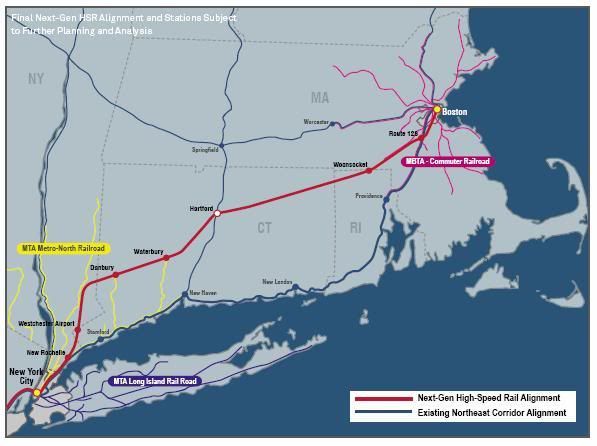 The way I put it in the comment thread at The Transport Politic is:
The way I put it in the comment thread at The Transport Politic is:
If the Master Plan is going to ease immediate capacity bottlenecks by 2017 and capacity is projected to be hit over far more of the corridor by 2030 even in the conservative projections that Amtrak makes, which ignores the effect of Peak Oil, then that would suggest that the Transport Authorization circa 2016/2018 would need to include provision for addressing that capacity constraint, since it takes a decade or more to build an all-new corridor.
That suggests that it would be useful to get a preliminary outline of the shape of that kind of system rolled out in advanced of the preceding Transport Authorization.
Which is now and this.
As shown above, for the section of the corridor that runs the furthest from the NEC, the NEC is an integral part of the transport system, and the Express HSR corridor provides an additional piece for that system.
And of course, I don’t expect to get this in the next transport authorization. But I expect that by the time the next transport authorization has expired, if there is a proposal out there, and we have had some experience in various parts of the country with both Regional and Express HSR systems, then we could well see an effort go ahead.
And under that kind of time horizon, if there are is a brand of political propaganda being pushed at the present by an Australian smut merchant and a Saudi Oil Prince, well, so what? With two or more severe oil price shocks highly likely between now and then, the durability of the Texas Tea Party (oil, that is) political strategy is not something to take for granted: we got to keep on planning for the future even if a radical right wing 20% of our population wants to toss this old Republic on the garbage heap of history in service to oil industry interests.
What Can We Do To Help?
There are a number of things we can do to help pursue this. First, completion of any Emerging, Regional, or Express HSR corridor and the launching of services will undermine negative propaganda (being bankrolled in part by oil interests). Second, support for funding of the Amtrak Master Plan for the NEC is a critical element for making this plan possible, since if local rail and shorter-range intercity rail can be made into rivals to Express HSR, it undermines both. Third, go visit the newly established Northeast HSR blog and give it the activity and links that such a site needs to thrive. And, of course, join Transportation for America, to network with people pushing for progressive transportation solutions coast to coast.
Midnight Oil ~ Truganini

1 comments
Author
… may it grow discussion … though of course by 2040, we’re supposed to be living in a Ghost in the Shell world, coping with the Stand Alone Complex …